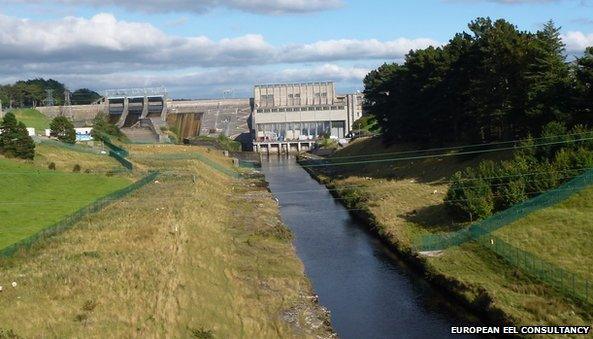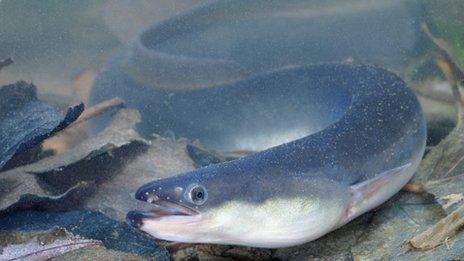Endangered eels die in power station trap at Ballyshannon
- Published

The trap was supposed to help eels safely pass the power station at Ballyshannon
Hundreds of thousands of critically endangered eels have died in a trap that was supposed to help their migration past a dam into Lough Erne.
Traps operated by the Republic of Ireland's electricity generating company ESB are supposed to assist the eels' migration around the hydroelectric power station in Ballyshannon, County Donegal.
ESB said an "unfortunate incident" took place over the Easter weekend that resulted in 112kg of juvenile eels, called elvers, being killed.

Numbers of juvenile eels have increased in recent years
It is understood no-one was checking the two traps at Cathaleen's Fall, external over the holiday weekend when there was a major run of eels up the River Erne.
When the traps became full, the eels had nowhere to go and it is thought that the elvers were starved of oxygen and died.
ESB said it was working with the Northern Ireland Department of Culture Arts and Leisure (DCAL) and Inland Fisheries Ireland (IFI) in carrying out a full investigation into the incident.
It said trapping protocols were being updated.
The European eel is a critically endangered species, and commercial fishing on the Erne was banned four years ago following an EU directive to try to reverse a 90% decline in stocks since the 1970s.
Eels migrate up to 4,000 miles from breeding sites in the Sargasso Sea across the Atlantic to Europe where they live for between five and 20 years in freshwater, before migrating back across the Atlantic to spawn.
Scientists who have been studying eels have reported an increase in the numbers of juvenile eels returning to European waters in recent years.
Dr William O'Connor from the European Eel Consultancy in Limerick said: "Everybody is surprised that over the past three years the numbers of juvenile eels, called glass eels or elvers, arriving into European rivers has increased markedly.
"This year we're in the middle of a particular record run of juvenile eels - perhaps the best run that has happened in the past 30 years."

The trap was supposed to help eels safely pass the power station at Ballyshannon
However, Dr O'Connor became concerned that the large numbers of eels reported in UK, French and Spanish rivers were not being recorded in Irish waterways, and he believes the system to trap and transport eels is not working as it should.
He said traps on the River Shannon were not operating at all until he raised his concerns at the beginning of May and, as a result, the first big run of eels of the season were unable to get passed the dam at Ardnacrusha.
'Tremendous opportunity'
He described the incident in Ballyshannon as a failure of international significance and estimated that more than 336,000 elvers had died.
"I know mistakes have been made and people have been caught off guard in terms of both elver trapping and the assisted migration programmes and also the monitoring of elver numbers, and we have quite clearly seen that this has not been done properly," he said.
"But the current upturn is a tremendous opportunity to manage eel stocks sustainably going forward and we'd like to see the positive message of this upturn.
"The European eel was a species that was all but written off up to two years ago and the species has certainly surprised everybody in eels with this fantastic turnaround in fortunes."
He said it was a "major and unnecessary kill of a critically endangered species".
ESB said despite the "regrettable incident" at Ballyshannon, as of 7 May, 461kg of live healthy elvers have been trapped at the station and successfully moved north into Lough Erne in conjunction with DCAL.
ESB said this represented a significant increase on previous elver runs and so the trapping operations by ESB and DCAL would continue as required.
- Published27 December 2013
